duets: alto flute and piano
-
Weber - Grand Duo Concertant - Alto Flute
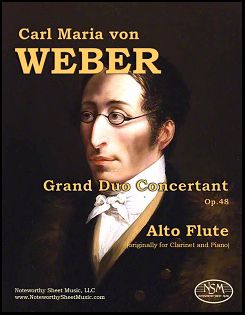 Grand Duo Concertant, Op.48, by Carl Maria von Weber
Grand Duo Concertant, Op.48, by Carl Maria von WeberTranscribed for Alto Flute and Piano by John W. Pratt
Alto Flute Part, PDF $9.98
Carl Maria von Weber (1786-1826), an important forerunner of the Romantic school, was a prolific composer, yet wrote only three substantial chamber works. One is the Grand Duo Concertant for clarinet (or violin) and piano. Sounding a bit like Mozart on steroids, with robust harmonies and brilliant passagework, it has three movements - an exciting Allegro con fuoco, a beautiful Andante with a very rich, chordal piano accompaniment and passionate piano interlude, and a sparkling Rondo. We offer this excellent alto flute transcription of the clarinet part; the piano part is readily available in the public domain, as a free high quality pdf download of the score for clarinet and piano; here is a link to the listing on imslp.org: Piano Score
Alto Flute part, 10 pages; Total, 12 pages.
Preview -
Dvořák - Ballada - Alto Flute & Piano
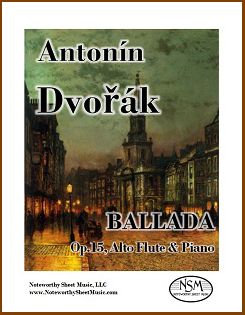 Ballada, Op. 15, by Antonín Dvořák
Ballada, Op. 15, by Antonín DvořákTranscribed for Alto Flute and Piano by C.A.Vater
Alto Flute Part and Piano Score, PDF $7.99
The Czech composer Antonín Leopold Dvořák (1841-1904) first visited England in 1884, at the invitation of the Philharmonic Society of London. He conducted several of his works there and and was commissioned to compose a new symphony for the Philharmonic Society, his Symphony No. 7 in D minor, Op.70, which he conducted in London on April 22, 1885. Dvořák, who was well-received in England for his longer works, including cantatas and oratorios, was asked by London publishers to write shorter compositions as well. The Ballada, composed by Dvořák in late 1884 shortly after he completed his Symphony No. 7, was written specifically for publication in the Christmas edition of the London Magazine of Music. It is a short work of approximately six minutes duration for violin and piano. Written in the key of D minor, the Ballad's outer sections are solemn and melancholy while the contrasting central Allegro agitato is fervid and intense. The piece works nicely on alto flute, and our transcription required few adaptations from the original violin part.
[Sources for Dvořák biographical information: Baker's Biographical Dictionary of Musicians (Eighth Edition, Revised by Nicolas Slonimsky) and the internet website http://www.antonin-dvorak.cz/en/ballad.]
Score, 8 pages; Alto Flute part, 3 pages; Total, 14 pages.
Preview -
Brahms ― Sonata, Op.120 No.1 ― Alto Flute
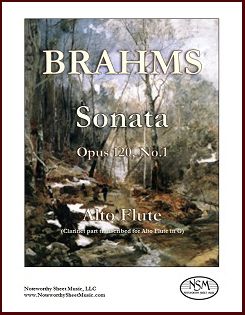 Sonata, Op.120 No.1, by Johannes Brahms
Sonata, Op.120 No.1, by Johannes BrahmsTranscribed for Alto Flute by J.W.Pratt
Alto Flute Part, PDF $8.99
Although written originally for clarinet, Brahms himself created two more versions of his Op.120 sonatas, for violin and viola. John W. Pratt, who transcribed these works for alto flute so expertly, writes in his foreword: "If Brahms was happy with versions for clarinet, viola, and violin, surely he would have welcomed arrangements for alto flute, especially since it is the mellow rather than the clarion aspect of the clarinet that he called on. In making our arrangements for alto flute, the violin versions have been particularly helpful, since the violin has the same lower range as the alto flute, but they required modification for several reasons. One, of course, is that the alto flute cannot play as loudly at the bottom of its range as the violin can. Another is that Brahms gave the violin double stops even though the clarinet is limited to a single voice." Our editions of the two Op.120 sonatas include only the alto flute parts, as Brahms' piano scores are freely available in the public domain. Here is a link to the listing of Op.120 No.1 on IMSLP.org, where the clarinet, viola, and violin versions with piano scores may be found. Our alto flute arrangements are based on the usual piano parts that accompany the clarinet as the solo instrument. The entire transcription of Op.120 No.1 works remarkably well, but the breathtakingly beautiful slow movement played on alto flute will steal your heart away.
Alto Flute part, 9 pages; Total 14 pages.
Preview -
Brahms ― Sonata, Op.120 No.2 ― Alto Flute
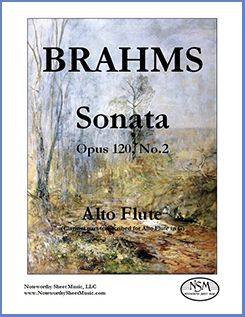 Sonata, Op.120 No.2, by Johannes Brahms
Sonata, Op.120 No.2, by Johannes BrahmsTranscribed for Alto Flute by J.W.Pratt
Alto Flute Part, PDF $8.99
This is the second of Brahms' two clarinet sonatas, transcribed for alto flute by John Pratt. Although written originally for clarinet, Brahms himself created two more versions of his Op.120 sonatas, for violin and viola. Mr. Pratt, who transcribed these works for alto flute so expertly, writes in his foreword: "If Brahms was happy with versions for clarinet, viola, and violin, surely he would have welcomed arrangements for alto flute, especially since it is the mellow rather than the clarion aspect of the clarinet that he called on. In making our arrangements for alto flute, the violin versions have been particularly helpful, since the violin has the same lower range as the alto flute, but they required modification for several reasons. One, of course, is that the alto flute cannot play as loudly at the bottom of its range as the violin can. Another is that Brahms gave the violin double stops even though the clarinet is limited to a single voice." Our editions of the two Op.120 sonatas include only the alto flute parts, as Brahms' piano scores are freely available in the public domain. Here is a link to the listing of Op.120 No.2 on IMSLP.org, where the clarinet, viola, and violin versions with piano scores may be found. Our alto flute arrangements are based on the usual piano parts that accompany the clarinet as the solo instrument.
Alto Flute part, 8 pages; Total, 12 pages.
Preview -
Haydn - Adagio, Quartet Op.17, No.1 - Afl & Pf
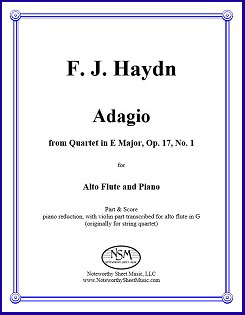 Adagio from Quartet in E Major, Op.17, No.1, by F. J. Haydn
Adagio from Quartet in E Major, Op.17, No.1, by F. J. HaydnTranscribed for Alto Flute and Piano by John W. Pratt
Alto Flute Part and Piano Score, PDF $8.00
Haydn's early quartets, especially the three sets of six written between 1768 and 1771 (Opus 9, Opus 17, and Opus 20), advanced the development of the classical string quartet enormously in all respects. The third movement of Opus 17, No. 1 is an Adagio with a beautiful violin melody that is harmonized simply by the other three strings. Whereas Haydn's more complex movements generally are unsuitable for transcription, the relative simplicity of this gorgeous Adagio makes it an exception. We present here a transcription for alto flute and piano. The melody is highly effective on the alto flute, and the other string parts are readily adaptable to the piano.
Alto Flute part, 2 pages of music; Piano score, 6 pages; Total, 12 pages.
Preview -
Fauré - Sicilienne - Alto Flute
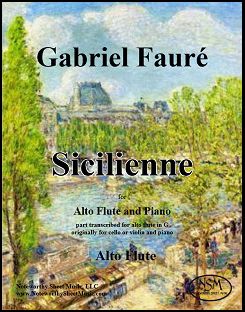 Sicilienne, Op.78, by Gabriel Fauré
Sicilienne, Op.78, by Gabriel FauréTranscribed for Alto Flute (and Piano) by C.A.Vater
Alto Flute Part, PDF $3.79
Sicilienne (Opus 78) was composed by Gabriel Fauré in 1893 and first published as a chamber music version for solo cello or violin with piano accompaniment in 1898. Numerous transcriptions of this popular piece have been made, including arrangements for flute and piano, viola and piano, horn and piano, flute and harp, 2 flutes and piano, flute and clarinet, and piano solo, among others. Our alto flute part is a transcription based on the original violin and cello parts of the edition published by J. Hamelle in 1898. We provide only the transcribed alto flute part; the piano accompaniment is readily available as a free pdf download of the original score for piano and cello, now in the public domain.
Alto Flute part, 2 pages of music; Total, 4 pages.
-
Schumann - Sonata in A minor - Alto Flute
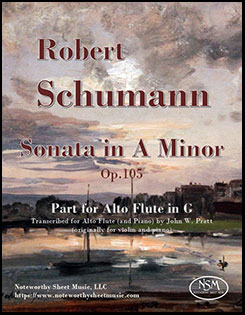 Sonata in A minor, Op.105, by Robert Schumann
Sonata in A minor, Op.105, by Robert SchumannTranscribed for Alto Flute (and Piano) by John W. Pratt
Alto Flute Part, PDF $8.99
Sonata in A Minor, Opus 105, was the first of two violin sonatas composed by Robert Schumann in 1851. The first movement has a gentle melody very well suited to the alto flute and the kind of flowing piano accompaniment and overlapping harmonies one finds in much of Schumann's chamber music. The Allegretto, with its hesitations and shifting moods and motifs, is also well suited to the alto flute. The restless final movement is exciting and effective (and a workout for both players) whatever solo instrument is used. The range and dynamics of Schumann's violin part, as well as its character, fit the alto flute's nature and capabilities beautifully. We provide our alto flute transcription of the violin part; the piano score and original violin part are available elsewhere in the public domain as free pdf downloads (click on the link).
Alto Flute part, 9 pages of music; Total, 12 pages.
Preview -
Reger - Albumblatt - Alto Flute & Piano
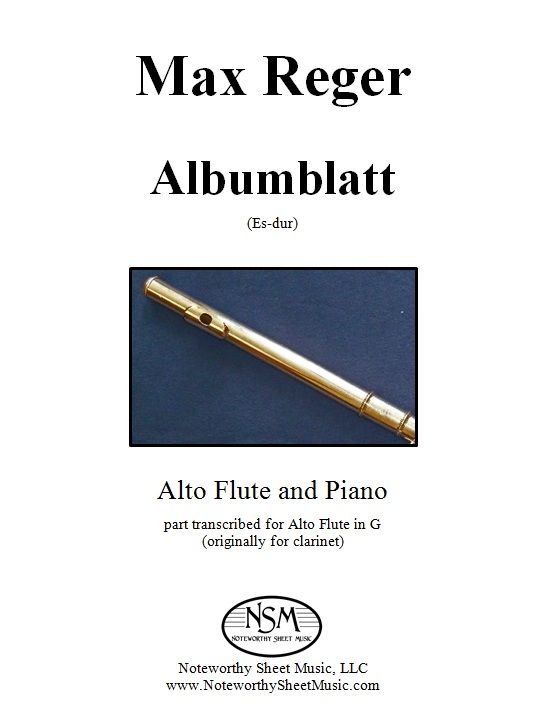 Albumblatt, by Max Reger
Albumblatt, by Max RegerTranscribed for Alto Flute and Piano by Carol A. Vater
Piano Score and Alto Flute Part, PDF $3.97
This gorgeous and surprisingly complex Albumblatt in E-flat major was written by Max Reger in ~1902 and originally scored for clarinet and piano. The piece is beautifully-suited to the range and sonority of the alto flute, and we provide here both our alto flute transcription of the clarinet part and a re-notated edition of the piano score.
Piano score, 2 pages; Alto Flute part, 1 page; Total, 5 pages.
-
Mozart - Sonata in E minor - Alto Flute
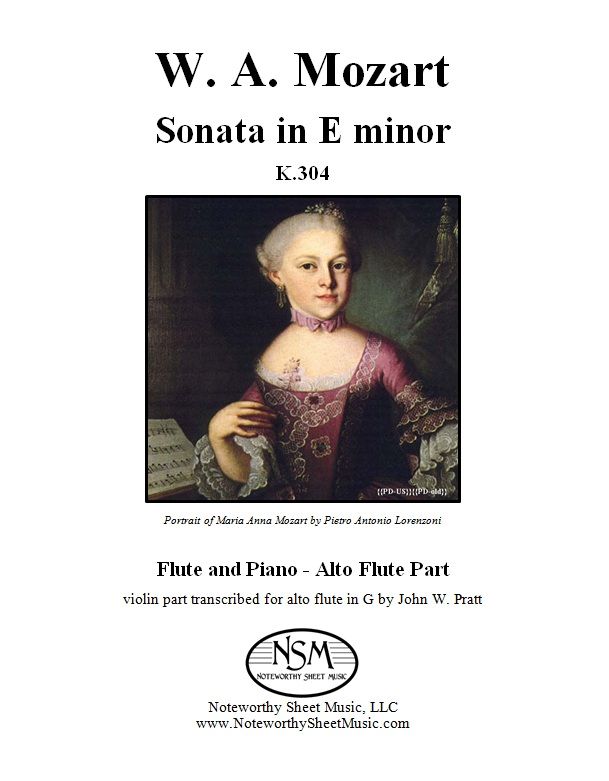 Sonata in E minor, K.304, by W. A. Mozart
Sonata in E minor, K.304, by W. A. MozartTranscribed for Alto Flute and Piano by John W. Pratt
Alto Flute Part, PDF $5.99
Mozart's second group of violin sonatas, the seven "Mannheim" sonatas of 1778, were begun in Mannheim where Mozart also worked on a flute commission. The violin parts rarely make significant use of double stops and are in general very well suited to alto flute. It is perhaps suggestive for performance that Mozart designated all his violin sonatas for "piano and violin".
Mozart's works in minor keys are rare and special: consider the G-minor quintet and Symphony No. 40. The K.304 sonata is his only work in E minor and it is mysteriously compelling in its simplicity. It was written the same summer that his mother died.
We provide the transcribed alto flute part; the piano score is readily available in the public domain, free of charge.
For additional information about the seven Mozart Mannheim sonatas and their alto flute transcriptions, please read the Mozart’s Mannheim Sonatas article written by Mr. Pratt; the article was originally published by Flute Focus and subsequently republished by NSM on our Resources – Reviews and Articles page.
Alto Flute part, 5 pages; Total, 8 pages.
Preview -
Haydn - Adagio, Quartet Op.17, No.2 - Afl & Pf
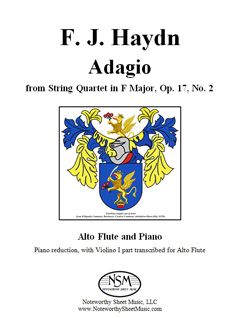 Adagio from Quartet in F Major, Op.17, No.2, by F. J. Haydn
Adagio from Quartet in F Major, Op.17, No.2, by F. J. Haydn Transcribed for Alto Flute and Piano by John W. Pratt
Alto Flute Part and Piano Score, PDF $8.00
The third movement of Haydn's Opus 17, No. 2, like that of Opus 17, No. 1, is an Adagio with a beautiful violin melody that is harmonized simply by the other three strings. The melody is compelling on alto flute, with just a few changes to accommodate its sonic differences from the violin. Lest the effect be too placid when the lower string parts are transferred to the piano, our piano transcription elaborates them in the style of Haydn's keyboard music in several places. We also incorporate a few changes for better sonority and to disentangle the voices where the string parts have overlaps and unisons that are poorly suited to the piano. All told, this transcription is highly effective and a delight for both players.
Alto Flute part, 2 pages of music; Piano score, 6 pages of music; Total, 12 pages.
Preview -
Mozart - Concerto in D Major - Alto Flute
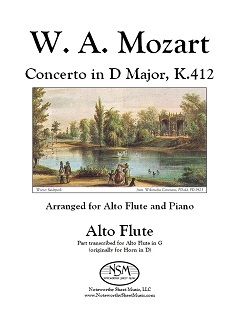 Concerto in D Major, K.412, by W. A. Mozart
Concerto in D Major, K.412, by W. A. Mozart Transcribed (from horn and piano arrangement) for Alto Flute by C.A.Vater
Alto Flute Part, PDF $3.99
Mozart's Concerto for Horn in D major for Horn and Orchestra is scored for solo horn in D, with two oboes, two bassoons, and strings. Henri Kling (1842-1918), horn player, composer, conductor, and professor, arranged the concerto for horn and piano. We used the Kling arrangement as the source from which to create a transcription of the horn part for alto flute. The piano scoreis in the public domain and available as a free pdf download from other sources such as imslp.org/.
The Concerto in D major, K.412 is a short work of approximately 8-10 min duration, consisting of only two movements - an Allegro and a Rondo Allegro. The movements are light and joyous, and pose no particular technical challenges to the alto flute player. The written range is quite limited, extending only from D5 to E6. Thus, this piece can be played by less advanced students as well as by more experienced alto flutists.
Alto Flute part, 4 pages of music; Total, 8 pages.
Preview -
Bloch - Petite Fantaisie Hongroise - Pf & Afl
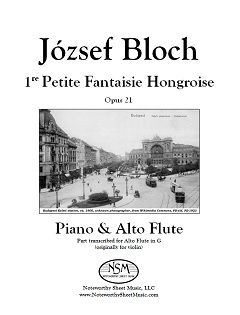 Petite Fantaisie Hongroise No.1, Op.21, by J. Bloch
Petite Fantaisie Hongroise No.1, Op.21, by J. Bloch Transcribed for Alto Flute and Piano by C.A.Vater
Piano Score and Alto Flute Part, PDF $5.99
József Bloch (1862-1922) was a Hungarian violin virtuoso, composer, and professor at the National Academy of Music and the National Conservatory (www.jewishencyclopedia.com). His Petite Fantaisie Hongroise No.1, Opus 21, was written for piano and violin and published by Bárd, ca. 1901. We thought this piece would work beautifully on alto flute, so we created a transcription of the violin part. In the range written for the Petite Fantaisie Hongroise, the alto flute may evoke the dark, mournful tone of the modern tárogató, which is often referred to as the Hungarian national instrument. We provide both our transcribed alto flute part and a re-notated edition of the piano score.
Alto Flute part, 3 pages; Piano Score, 6 pages; Total, 12 pages.
Preview
=================================
For those who would prefer to purchase a professionally-printed hard copy of this piece, rather than the PDF download offered above, our print edition of the Bloch Petite Fantaisie Hongroise No.1, Op. 21 transcribed for Piano & Alto Flute is available directly from NSM for $13.49 plus a $5.95 shipping and handling fee to addresses in the USA. Use the Contact Us form to let us know which hard copy publication(s) you would like to purchase, along with your email contact information and USPS mailing address. We will then send you a PayPal invoice for the sale and, once we receive notice from PayPal that you have paid for the item(s), we will ship your music to the address provided.
-
Mozart - Sonata in G Major - Alto Flute
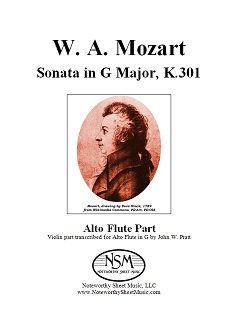 Sonata in G Major, K.301, by W. A. Mozart
Sonata in G Major, K.301, by W. A. MozartTranscribed for Alto Flute and Piano by John W. Pratt
Alto Flute Part, PDF $4.99
This sunny sonata has two movements, an up-beat Allegro con spirito followed by an Allegro that is actually a sprightly minuet with a trio section in the minor, almost as near to a Beethoven scherzo as a Haydn minuet. The violin leads as often as the piano, including at the beginning and throughout the trio, but is largely spared Mozart's typical keyboard passage work. As with six other violin sonatas composed in 1778, the first of Mozart's maturity, the violin part rarely makes significant use of double stops and is in general very well suited to alto flute. In fact, K.301 was begun with flute in mind. We provide our transcribed alto flute part. The piano score is available in the public domain as a free pdf download from imslp.org/.
For additional information about the seven Mozart Mannheim sonatas and their alto flute transcriptions, please read the Mozart’s Mannheim Sonatas article written by Mr. Pratt; the article was originally published by Flute Focus and subsequently republished by NSM on our Resources – Reviews and Articles page.
Alto Flute part, 4 pages; Total, 6 pages.
Preview -
Mozart - Sonata in E-flat Major, K.302 - Alto Flute
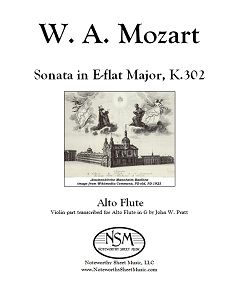 Sonata in E-flat Major, K.302, by W. A. Mozart
Sonata in E-flat Major, K.302, by W. A. MozartTranscribed for Alto Flute and Piano by John W. Pratt
Alto Flute Part, PDF $4.99
Mozart's Sonata in E-flat Major, K.302 has two movements, an Allegro and a rondo Andante grazioso. This ebullient sonata opens with a striking call to attention, much used later, which descends on the tonic triad but alternates half and quarter notes in 3/4 time, thus avoiding both square rhythm and repeated root positions on every down beat. The theme which follows is contrastingly gentle. The second movement offers a firmly forward-moving theme whose immediate repeat and final returns are variously and charmingly re-orchestrated. (excerpted from JWP's foreword to the edition)
We provide our transcription of the violin part for alto flute; the piano score is available in the public domain as a free pdf download from imslp.org/.
For additional information about the seven Mozart Mannheim sonatas and their alto flute transcriptions, please read the Mozart’s Mannheim Sonatas article written by Mr. Pratt; the article was originally published by Flute Focus and subsequently republished by NSM on our Resources – Reviews and Articles page.
Alto Flute part, 5 pages; Total, 8 pages.
Preview -
Mozart - Sonata in C Major, K.303 - Alto Flute
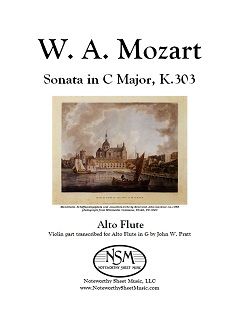 Sonata in C Major, K.303, by W. A. Mozart
Sonata in C Major, K.303, by W. A. MozartTranscribed for Alto Flute and Piano by John W. Pratt
Alto Flute Part, PDF $4.99
Both movements of Mozart's Sonata in C Major, K.303 are quite different from others of his 'Mannheim' set. The unusual first movement is in sonata form mixing retro and novel features—the whole first subject and transition to the dominant are adagio and considerably varied in the recapitulation, and there is no development. The second movement is an old-style minuet (without trio), ending with a pedal point terminating in a tremble. Our transcription for alto flute shifts the violin part to a different octave in three short segments and we have substituted musically appropriate alternatives for the double stops. We provide our transcription of the violin part for Alto Flute in G; the piano scoreis available in the public domain as a free pdf download from imslp.org/.
Alto Flute part, 5 pages; Total, 8 pages.
Preview -
Haydn - Adagio from Sym. No.24 - Afl & Pf
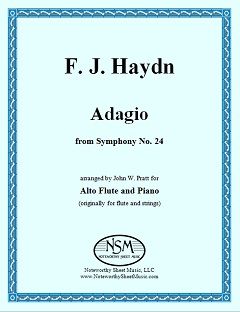 Adagio from Symphony No.24, by F. J. Haydn
Adagio from Symphony No.24, by F. J. HaydnArranged for Alto Flute and Piano by John W. Pratt
Alto Flute Part and Piano Score, PDF $6.00
We offer a flute and piano edition of the gorgeous second movement Adagio for solo flute accompanied by strings from Haydn's Symphony No.24. An arrangement for alto flute that is mellower than that for flute but also extremely beautiful is obtained by lowering the pitch a minor third. Haydn's flute part needs no other change, nor does the cadenza that was written by Mr. Pratt for our C-flute edition. The string parts have been adapted to piano sonority in a number of ways, as well as transposing them in this alto flute edition.
Alto Flute part, 2 pages; Alto Flute & Piano score, 4 pages; Total, 10 pages.
Preview -
Mozart - Sonata in A Major, K.305 - Alto Flute
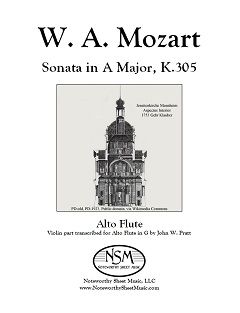 Sonata in A Major, K.305, by W. A. Mozart
Sonata in A Major, K.305, by W. A. MozartTranscribed for Alto Flute and Piano by John W. Pratt
Alto Flute Part, PDF $3.99
Mozart's Sonata in A Major, K.305 is perhaps the most completely extroverted of the Mannheim sonatas. Like K.302, it opens with four emphatically tonic bars, followed by a gentle, linear four-bar theme, all immediately repeated. The second movement of K.305 is the only movement of the Mannheim sonatas in theme-and-variations form. It is far from routine. The theme has an unusual variety of rhythms and accompaniment figurations; the 32nd-note variation is the very first, not a later one; the minor variation is at the prevailing tempo, not slow; and a brief but telling piano cadenza interrupts the antepenultimate variation's peroration. (excerpted from JWP's foreword to the edition)
We provide the transcribed alto flute part—the piano scoreis available in the public domain as a free pdf download from imslp.org/.
Alto Flute part, 4 pages; Total, 6 pages.
Preview -
Mozart - Sonata in D Major, K.306 - Alto Flute
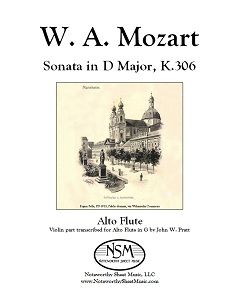 Sonata in D Major, K.306, by W. A. Mozart
Sonata in D Major, K.306, by W. A. MozartTranscribed for Alto Flute and Piano by John W. Pratt
Alto Flute Part, PDF $9.99
Mozart's Sonata in D Major, K.306 is by far the longest and showiest of the 'Mannheim' sonatas, with three large-scale movements, some quasi orchestral textures, much doubling, and brilliant passage work. The first movement's development expands four transitional bars of the exposition into a far-reaching harmonic excursion. The recapitulation begins with the second subject and returns to the first so late it amounts to a coda, the only instance of 'mirror' sonata-form in the Mannheim set. In contrast, the second movement, Andante cantabile, has a structurally orthodox sonata form, compressing and ornamenting the themes in the recapitulation, as befits the tempo. The finale is an elaborate rondo alternating between allegretto in 2/4 and allegro in 6/8. (excerpted from JWP's foreword to the edition)
We provide our transcribed alto flute part; the piano scoreis available in the public domain as a free pdf download from imslp.org/.
Alto Flute part, 10 pages; Total, 12 pages.
Preview -
Mozart - Sonata in C Major, K.296 - Alto Flute
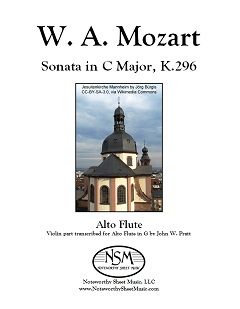 Sonata in C Major, K.296, by W. A. Mozart
Sonata in C Major, K.296, by W. A. MozartTranscribed for Alto Flute and Piano by John W. Pratt
Alto Flute Part, PDF $6.99
Mozart composed K.296 in 1778 under the same creative impulse as the other Mannheim violin sonatas, K.301‒306, but published it later, in 1781, with five other three-movement sonatas. He dedicated it to his Mannheim landlord's 15-year old daughter, Therese-Pierron Serrarius, who perhaps inspired the turns lightening the opening fanfares, quick trills in the first theme, and contrasting textures and sparkling interplay between the instruments in the first movement. The second movement is a beautiful arietta with wonderful opportunities for the alto flute to both present and accompany the melody. In the concluding Rondo, in sonata-rondo form, the instruments repeatedly swap the theme and much of the episodic material. ―J. W. Pratt
We provide our transcription of the violin part for alto flute; the piano score is available in the public domain as a free pdf download from imslp.org/.
For additional information about the seven Mozart Mannheim sonatas and their alto flute transcriptions, please read the Mozart’s Mannheim Sonatas article written by Mr. Pratt; the article was originally published by Flute Focus and subsequently republished by NSM on our Resources – Reviews and Articles page.
Alto Flute part, 7 pages; Total, 10 pages.
Preview -
Schubert - Sonatas, Op.137 - Alto Flute
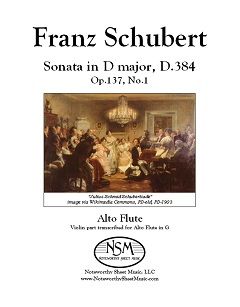 Sonatas, Op.137, by F. Schubert
Sonatas, Op.137, by F. SchubertTranscribed for Alto Flute and Piano by C. A. Vater & J. W. Pratt
No.1, Sonata in D major, D.384, Alto Flute Part, PDF $5.99
No.2, Sonata in A minor, D.385, Alto Flute Part, PDF $7.99
No.3, Sonata in G minor, D.408, Alto Flute Part, PDF $5.99
Franz Schubert (1797-1828) wrote his three violin sonatas Opus 137 when he was barely 19. They were published posthumously as 'Sonatinas', perhaps for marketing reasons, but they are full-scale sonatas in traditional classical style and format, the first having three movements and the others four. These plus the violin sonata in A of the next year constitute fully half of Schubert's known works for piano and solo instrument.
Schubert's Op.137 sonatas are truly delightful, and we have adapted the violin parts for alto flute. Where appropriate, changes have been introduced to better accommodate the range, sonority, and general characteristics of the alto flute. Such modifications include occasional octave adjustments, dynamic changes, and suitable flute-friendly alternatives to the violin's doublestops. We provide our transcribed alto flute parts; the piano scores are readily available in the public domain as free pdf downloads from imslp.org/.
No.1, Sonata in D major: Alto Flute part, 6 pages; Total, 8 pages. PDF $5.99
Preview
No.2, Sonata in A minor: Alto Flute part, 8 pages; Total, 10 pages. PDF $7.99
Preview
No.3, Sonata in G minor: Alto Flute part, 6 pages; Total, 8 pages. PDF $5.99
Preview